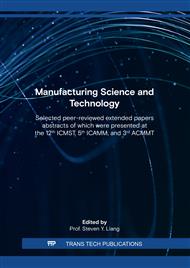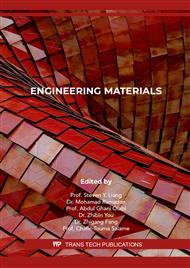[1]
H. Varum. Camata.Structural Behaviour and Retrofitting of Adobe Masonry Buildings Pathology and Rehabilitation, Structural Rehabilitation of Old Buildings, vol. 02, pp.37-75, (2014).
DOI: 10.1007/978-3-642-39686-1_2
Google Scholar
[2]
E. Quagliarini. The properties and durability of adobe earth-based masonry blocks. Eco-Efficient Masonry Bricks and Blocks, pp.361-378, (2015).
DOI: 10.1016/b978-1-78242-305-8.00016-4
Google Scholar
[3]
H. Houben. CRAterre., & Intermediate Technology Publications, Earth construction: A comprehensive guide, (1994).
Google Scholar
[4]
F.Gatti. A Resource on Construction in Earthquake Regions, Earthquake Engineering Research Institute, (2003).
Google Scholar
[5]
P. Quiroz. Obtention of the mechanical properties of the adobe asonry using (lab based) experimental test. Acta Universitario Multidisciplinary Scientific Journal, vol. 29, pp.1-13, (2019).
Google Scholar
[6]
L. Yamin. Seismic vulnerability studies, renovation and reinforcement of houses built with adobe brick and rammed earth, Apuntes Journal of Cultural Heritage Studies, vol. 20, no. 5, pp.286-303, (2007).
Google Scholar
[7]
E. Lagos-Burbano. Sugar cane and by-products of the sugar agro-industry in ruminant feeding: A review, Agronomía Mesoamerican, vol. 30, no. 3, pp.917-934, (2019).
Google Scholar
[8]
E. Sera. Natural Fibers as Reinforcement, Journal of ferrocement, vol. 20, no. 2, pp.797-809, (1990).
Google Scholar
[9]
F. Hernández-Olivares. Short sugarcane bagasse fibers cementitious composites for building construction, Construction and Building Materials, vol. 247, 118451, (2020).
DOI: 10.1016/j.conbuildmat.2020.118451
Google Scholar
[10]
Danso. H. Physical, mechanical and durability properties of soil building blocks reinforced with natural fibers, Construction and Building Materials, vol. 101, no. 1, pp.797-809, (2015).
DOI: 10.1016/j.conbuildmat.2015.10.069
Google Scholar
[11]
S. Raj. Coconut Fibre Reinforced Cement Stabilized Rammed Earth Blocks. World Journal of Engineering, vol.14, no. 3, pp.208-216, (2017).
DOI: 10.1108/wje-10-2016-0101
Google Scholar
[12]
Y. Millogo. Experimental analysis of Pressed Adobe Blocks reinforced with Hibiscus cannabinus fibers. Construction and Building Materials, vol.52, pp.71-78, (2014).
DOI: 10.1016/j.conbuildmat.2013.10.094
Google Scholar
[13]
K. Thanushan. Strength and Durability Characteristics of Coconut Fiber Reinforced Earth Cement Blocks. Natural Fibers, pp.1-16, (2019).
DOI: 10.1080/15440478.2019.1652220
Google Scholar
[14]
H. Danso. Effect of sugarcane fiber on the strength properties of soil blocks, Bio-based Building Materials, (2015).
Google Scholar
[15]
S. A. Lima. Analysis of the mechanical properties of compressed earth block masonry using the sugarcane bagasse ash, Construction and Building Materials, vol. 35, pp.829-837, (2012).
DOI: 10.1016/j.conbuildmat.2012.04.127
Google Scholar
[16]
NTP E.080, Diseño y Construcción con tierra reforzada.
Google Scholar
[17]
CE.020, Suelos y Taludes. Ministerio de Vivienda, Construcción y Saneamiento.
Google Scholar
[18]
ASTM D 2974-14, Standard Test Methods for Moisture, Ash, and Organic Matter of Peat and Other Organic Soils.
DOI: 10.1520/d2974-14
Google Scholar
[19]
ASTM D 854-14, Standard Test Methods for Specific Gravity of Soil Solids by Water Pycnometer.
Google Scholar
[20]
ASTM D 4318-17e1, Standard Test Methods for Liquid Limit, Plastic Limit, and Plasticity Index of Soils.
Google Scholar
[21]
C 136M-14, Standard Test Method for Sieve Analysis of Fine and Coarse Aggregates.
Google Scholar
[22]
T, Casusol. Origen y elaboración agroindustrial de la caña de azúcar, Universidad Nacional de Ecucación Enrique Guzmán y Valle, Lima, Perú. (2019).
DOI: 10.36996/delectus.v4i2.136
Google Scholar
[23]
K. Ghavami. Behavior of composite soil reinforced with natural fibers. Cement & Concrete Composites, vol. 21, pp.39-48, (1999).
DOI: 10.1016/s0958-9465(98)00033-x
Google Scholar
[24]
ASTM C-150, Standard Specification for Portland Cement, (1998).
Google Scholar
[25]
ASTM C1602, Standard Specification for Mixing Water Used in the Production of Hydraulic Cement Concrete, (2018).
Google Scholar
[26]
M.S. Islam. Effectiveness of fly ash and cement for compressed stabilized earth block construction, Construction and Building Materials, 255, 119392, (2020).
DOI: 10.1016/j.conbuildmat.2020.119392
Google Scholar
[27]
J. Bogas. Unsterilized and stabilized compressed earth blocks with partial incorporation of recycled aggregates. International Journal of Architectural Heritage, vol. 13(4), pp.569-584. (2019).
DOI: 10.1080/15583058.2018.1442891
Google Scholar
[28]
CEN.EN772-1 Methods of test for masonry units. Part 1: Determination of compressive strength, European Committee for Standardization, Brussels.
Google Scholar
[29]
CEN.EN772-6, Methods of test for masonry units. Determination of bending tensile strength of aggregate concrete masonry units.
DOI: 10.3403/02442078
Google Scholar
[30]
UNE-EN 772-11, Methods of test for masonry units-Part 11. Determination of water absorption of aggregate concrete and natural stone masonry units due to capillary action and the initial rate of water absorption of clay masonry units.
DOI: 10.3403/02091572u
Google Scholar
[31]
P. Nshimiyimana. Thermophysical and mechanical properties of compressed earth blocks containing fibres: By-product of okra plant & polymer waste. WIT Transactions on the Built Environment, vol 195, pp.149-16, (2020).
DOI: 10.2495/arc200121
Google Scholar
[32]
B. Taallah. Mechanical properties and hygroscopicity behavior of compressed earth block filled by date palm fibers. Construction and Building Materials, 59, 161-168, (2014).
DOI: 10.1016/j.conbuildmat.2014.02.058
Google Scholar
[33]
C. Chan. Effect of natural fibres inclusion in clay bricks: Physico-mechanical properties. World Academy of Science, Engineering and Technology. 73. 51-57, (2011).
Google Scholar
[34]
M. Bouhicha. Barley Straw reinforced composite soil Yiel. Cement & Concrete Composites, vol. 27, pp.617-621, (2005).
DOI: 10.1016/j.cemconcomp.2004.09.013
Google Scholar



